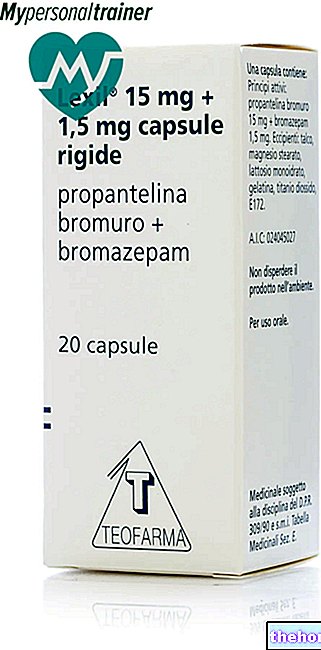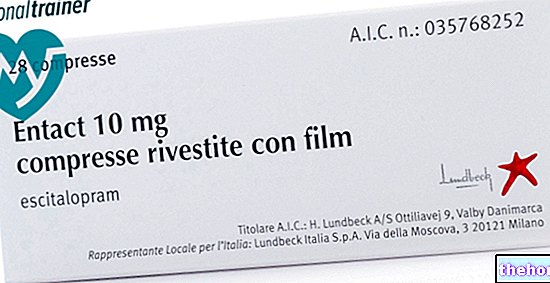Active ingredients: Otilonium bromide, Diazepam
OBISPAX 40 mg + 2 mg coated tablets
Why is Obispax used? What is it for?
OBISPAX contains the active ingredients otilonium bromide, a substance with a spasmolytic action (that is, it induces relaxation) at the level of the smooth muscles of the digestive system, and diazepam, a benzodiazepine with an anxiolytic action (reduces anxiety).
OBISPAX is used in adults in the treatment of spastic-painful manifestations (strong contractions of the muscles associated with pain) with an anxious component of the gastrointestinal tract.
Contraindications When Obispax should not be used
Do not take OBISPAX
- If you are allergic to the active substances (otilonium bromide, diazepam) or to any of the other ingredients of this medicine (listed in section 6);
- if you suffer from glaucoma (increased pressure inside the eye);
- in case of prostatic hypertrophy (enlargement of the prostate);
- in case of intestinal obstruction syndromes (arrest of bowel contents progression due to the presence of an obstacle or obstruction) or urinary retention (inability to pass urine from the bladder);
- in case of myasthenia gravis (disease characterized by muscle weakness). Taking OBISPAX is contraindicated during the first trimester of pregnancy (see "Pregnancy and breastfeeding"). It is also not recommended in infancy (see "Children and adolescents").
Precautions for use What you need to know before taking Obispax
Talk to your doctor or pharmacist before taking OBISPAX.
If you are taking OBISPAX for a long time it is advisable to have your blood picture (blood tests) and liver function (liver) checked. In subjects predisposed, treatment with benzodiazepines at high doses and for prolonged periods can lead to dependence, as it occurs with other drugs with hypnotic activity (which induce sleep), sedative (calming) and ataraxic (with tranquilizing action).
Since the individual reactivity (personal response to the drug) is highly variable, if you are elderly or debilitated the dose of OBISPAX should be established with caution (see section 3 "How to take OBISPAX").
Children and adolescents
OBISPAX contains otilonium bromide and diazepam, an anxiolytic benzodiazepine. The use of benzodiazepines in early childhood is not usually recommended (see "Do not take OBISPAX").
Interactions Which drugs or foods may change the effect of Obispax
Tell your doctor or pharmacist if you are taking, have recently taken or might take any other medicines.
The concomitant use of OBISPAX and other psychotropic drugs requires particular caution and vigilance on the part of the physician to avoid unexpected undesirable effects of interaction.
Take OBISPAX with caution in combination with centrally acting medicines (which act in the central nervous system), such as neuroleptics (antipsychotic medicines used to treat some psychiatric conditions, such as schizophrenia, bipolar disorder and some forms of depression), antidepressants, hypnotics (drugs that induce sleep), analgesics (reduce pain) and anesthetics (drugs capable of inducing the temporary loss of pain sensation), as this combination can increase the sedative action.
OBISPAX with alcohol
Do not drink alcoholic beverages during treatment with OBISPAX as, as with any other psychotropic (psychoactive) medicine, individual reactions are not predictable.
Warnings It is important to know that:
Pregnancy and breastfeeding
If you are pregnant or breast-feeding, think you may be pregnant or are planning to have a baby, ask your doctor or pharmacist for advice before taking this medicine.
Pregnancy
Do not take OBISPAX in the first trimester of pregnancy (see "Do not take OBISPAX"). In the second and third trimester of pregnancy, take OBISPAX only when clearly needed when, in your doctor's opinion, the possible benefits outweigh the possible risks.
Feeding time
If you are breastfeeding, take OBISPAX only when clearly needed when, in the opinion of your doctor, the possible benefits outweigh the possible risks.
Driving and using machines
OBISPAX, like other drugs with the same mechanism of action, can affect the ability to drive and use machines.
Dose, Method and Time of Administration How to use Obispax: Posology
Always take this medicine exactly as your doctor or pharmacist has told you.
If in doubt, consult your doctor or pharmacist.
The recommended dose is 1- 3 tablets a day, according to the doctor's judgment, to be taken preferably after meals.
However, the choice of the most appropriate posology must be guided by the characteristics of the pharmacological association (otilonium bromide + diazepam) and not by those of the individual components.
In elderly patients, the dosage should be carefully established by the physician who will have to evaluate a "possible reduction of the dosages indicated above (see" Warnings and precautions ").
The duration of treatment may vary according to the nature and severity of the disease, according to the doctor's judgment.
If you forget to take OBISPAX
Do not take a double dose to make up for a forgotten dose.
If you have any further questions on the use of this medicine, ask your doctor or pharmacist.
Overdose What to do if you have taken an overdose of Obispax
In animals, otilonium bromide has been shown to be practically free of toxicity. Consequently, also in the man should not arise particular problems due to overdose.
Manifestations of diazepam overdose include somnolence, confusion, coma, reduced reflexes. Although these effects are generally minimal, respiration, pulse (heart rate), blood pressure should be monitored, and general supportive measures associated with immediate gastric lavage (stomach emptying) should be implemented.
Side Effects What are the side effects of Obispax
Like all medicines, this medicine can cause side effects, although not everybody gets them.
The following side effects may occur with the use of OBISPAX:
Rare side effects:
- ataxia (alteration of muscle coordination which makes it difficult to perform certain movements);
- headache (headache);
- nausea, vomiting, diarrhea, constipation (constipation), abdominal pain;
- palpitations (increased perception of one's heart beat);
- vision disturbances;
- hypotension (low blood pressure);
- dry mouth;
- itching, rash (appearance of more or less prominent red spots on the skin);
- drooling (excessive saliva production);
- depression, confusion, hallucinations;
- cases of granulocytopenia (decrease in the concentration of granulocytes, a type of white blood cell, in the blood);
- changes in blood levels (blood concentration) of transaminases (enzymes whose concentration in the blood indicates the presence of liver disease), phosphatase (enzyme that provides information on the possible presence of bone, liver, pancreas and intestine), bilirubin (colored substance present in the bile resulting from the degradation of hemoglobin);
- irritability.
Undesirable effects with frequency not known (frequency cannot be estimated from the available data):
- drowsiness;
- dizziness.
These side effects are more frequent in elderly or debilitated patients.
If they are signs of relative overdose (situation in which the drug is taken in compliance with the indicated dosages but, due to the presence, for example, of liver or kidney diseases, there is an increase in its concentrations in the blood), disappear spontaneously in a few days or after a dosage adjustment.
Reporting of side effects
If you get any side effects, talk to your doctor or pharmacist. This includes any possible side effects not listed in this leaflet. You can also report side effects directly to the national reporting system at: www.agenziafarmaco.gov.it/it/responsabili. By reporting side effects you can help provide more information on the safety of this medicine.
Expiry and Retention
Keep this medicine out of the sight and reach of children.
Do not use this medicine after the expiry date which is stated on the package after EXP. The expiry date refers to the last day of that month and to the unopened, correctly stored product.
This medicine does not require any special storage conditions.
Do not throw any medicines via wastewater or household waste. Ask your pharmacist how to throw away medicines you no longer use. This will help protect the environment.
Deadline "> Other information
What OBISPAX contains
Each coated tablet contains:
- Active ingredients: otilonium bromide 40 mg, diazepam 2 mg.
- Other components: microgranular cellulose, pregelatinised starch, carboxymethyl starch sodium salt, precipitated silica, magnesium stearate.
- Coating: hypromellose, titanium dioxide, talc, macrogol, iron oxides.
Description of what OBISPAX looks like and contents of the package
Pinkish, oblong coated tablets with an "M" debossed on one side.
Blister pack containing 30 coated tablets in a cardboard box.
Source Package Leaflet: AIFA (Italian Medicines Agency). Content published in January 2016. The information present may not be up-to-date.
To have access to the most up-to-date version, it is advisable to access the AIFA (Italian Medicines Agency) website. Disclaimer and useful information.
01.0 NAME OF THE MEDICINAL PRODUCT -
OBISPAX 40 MG + 2 MG COATED TABLETS
02.0 QUALITATIVE AND QUANTITATIVE COMPOSITION -
Each coated tablet contains:
Active ingredients: Otilonium bromide 40 mg, diazepam 2 mg
For the full list of excipients, see section 6.1
03.0 PHARMACEUTICAL FORM -
Coated tablet.
04.0 CLINICAL INFORMATION -
04.1 Therapeutic indications -
Spastic-painful manifestations, with an anxious component, of the gastrointestinal system.
04.2 Posology and method of administration -
1-3 tablets per day, preferably after meals, according to the doctor's judgment. However, the posology must be guided by the characteristics of the combination and not by those of the individual components.
In the treatment of elderly patients, the posology must be carefully established by the doctor, who will have to evaluate a possible reduction of the dosages indicated above.
The duration of the treatment is in relation to the nature and severity of the pathology, according to the doctor's judgment.
04.3 Contraindications -
Hypersensitivity to the active substances or to any of the excipients listed in section 6.1.
Subjects with glaucoma, prostatic hypertrophy, intestinal obstruction syndrome or urinary retention.
The use of benzodiazepines in early childhood is not generally recommended.
Myasthenia gravis.
Do not administer in the first trimester of pregnancy (see section 4.6).
04.4 Special warnings and appropriate precautions for use -
Predisposed subjects, if treated with benzodiazepines at high doses and for prolonged periods of time, may be addictive as occurs with other drugs with hypnotic, sedative and ataraxic activity. In case of prolonged treatment it is advisable to check the blood picture and liver function.
Due to the highly variable individual reactivity to psychotropic drugs, the dosage of OBISPAX 40 mg + 2 mg coated tablets should be set within prudent limits in elderly or debilitated patients. Patients under treatment with OBISPAX 40 mg + 2 mg coated tablets, as well as with any other psychotropic drug, should refrain from consuming alcoholic beverages while under the influence of the drug, as individual reactions are unpredictable.
Pediatric population
The use of benzodiazepines in early childhood is not generally recommended.
04.5 Interactions with other medicinal products and other forms of interaction -
Associated with centrally active drugs such as neuroleptics, antidepressants, hypnotics, analgesics and anesthetics, OBISPAX 40 mg + 2 mg coated tablets can reinforce their sedative action. The association with other psychotropic drugs requires particular caution and vigilance on the part of the physician to avoid unexpected undesirable effects from interaction.
04.6 Pregnancy and breastfeeding -
OBISPAX is contraindicated during the first trimester of pregnancy. In the further period of pregnancy and during lactation, the drug should be administered only in case of real need when, in the opinion of the physician, the possible benefits outweigh the possible risks (see section 4.3).
04.7 Effects on ability to drive and use machines -
OBISPAX 40 mg + 2 mg coated tablets, like other drugs of the same type of action, may affect the ability to drive and operate machinery.
04.8 Undesirable effects -
Nervous system disorders
Somnolence, dizziness. Rare: ataxia and headache.
Gastrointestinal disorders
Rare: nausea, vomiting, diarrhea, constipation, abdominal pain
Cardiac pathologies
Rare: palpitations.
Psychiatric disorders
Rare: confusion, irritability.
Visual disturbances, hypotension, pruritus, dry mouth, rash, drooling, depression, confusion, hallucinations, cases of granulocytopenia, changes in blood levels of transaminases, phosphatase, bilirubin.
These side effects are more frequent in elderly or debilitated patients.
If these are signs of relative overdose, they disappear spontaneously within a few days or after dosage adjustment.
Reporting of suspected adverse reactions
Reporting of suspected adverse reactions occurring after authorization of the medicinal product is important as it allows continuous monitoring of the benefit / risk balance of the medicinal product. Healthcare professionals are asked to report any suspected adverse reactions via the national reporting system. "address: www.agenziafarmaco.gov.it/it/responsabili.
04.9 Overdose -
In the animal, otilonium bromide has been shown to be practically free of toxicity. Consequently, no particular problems due to overdose should arise in humans either. Manifestations of diazepam overdose include drowsiness, confusion, coma, reduced reflexes. Breathing, pulse and blood pressure should be monitored although generally these effects are minimal in case Overdose General supportive measures should be used in conjunction with immediate gastric lavage.
05.0 PHARMACOLOGICAL PROPERTIES -
05.1 "Pharmacodynamic properties -
Pharmacotherapeutic group: Synthetic anticholinergics in combination with psycholeptics, ATC code: A03CA04
Otilonium bromide has an intense spasmolytic action on the smooth muscles of the digestive system. Its action is carried out through the inhibition of the contraction of the smooth muscle cells, through the interference of the mobilization of the extra and intra cellular Ca ++ ions. Diazepam is a benzodiazepine derivative with anxiolytic and muscle relaxant properties.
05.2 "Pharmacokinetic properties -
Experimental data have shown that after oral administration, the absorption of otilonium bromide is very poor (about 5% of the administered dose); most of the absorbed portion is eliminated via the biliary route. Diazepam, benzodiazepine derivative with anxiolytic action, administered orally at a dose of 2 mg, is rapidly absorbed reaching the blood peak at the 2nd hour. Simultaneously administered otylonium bromide does not interfere with the absorption of diazepam.
05.3 Preclinical safety data -
The oral LD50 of OBISPAX 40 mg + 2 mg coated tablets is 3445 times higher than the DTS and 575 times higher than the DTD. In chronic administration the drug was well tolerated even for doses several times higher than human therapeutic ones. In doses 10 times higher than the DTD, the drug has neither teratogenic effects nor negative effects on reproductive function.
06.0 PHARMACEUTICAL INFORMATION -
06.1 Excipients -
Each coated tablet contains:
Excipients:
Nucleus: microgranular cellulose, pregelatinised starch, carboxymethyl starch sodium salt, precipitated silica, magnesium stearate.
Coating: hypromellose, titanium dioxide, macrogols, talc, iron oxides.
06.2 Incompatibility "-
Not relevant
06.3 Period of validity "-
3 years.
06.4 Special precautions for storage -
This medicine does not require any special storage conditions.
06.5 Nature of the immediate packaging and contents of the package -
Cardboard box containing 30 coated tablets packed in PVC-PVDC and Aluminum blisters.
06.6 Instructions for use and handling -
No special instructions.
Unused medicine and wastes derived from this medicine must be disposed of in accordance with local regulations.
07.0 HOLDER OF THE "MARKETING AUTHORIZATION" -
Malesci Istituto Farmacobiologico S.p.A. - Via Lungo l "Ema, 7 - Bagno a Ripoli (Florence).
08.0 MARKETING AUTHORIZATION NUMBER -
A.I.C. n ° 027256027
09.0 DATE OF FIRST AUTHORIZATION OR RENEWAL OF THE AUTHORIZATION -
Date of first authorization: 01 June 1990
Date of most recent renewal: May 31, 2010
10.0 DATE OF REVISION OF THE TEXT -
December 2015




























